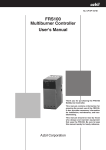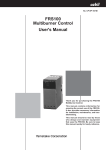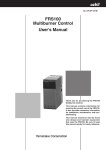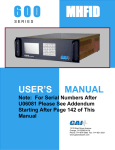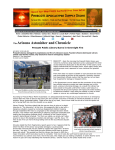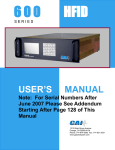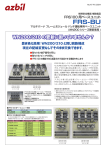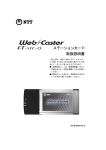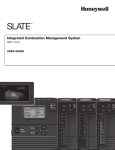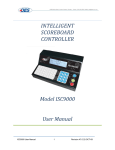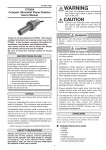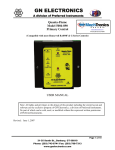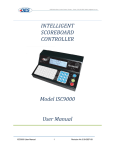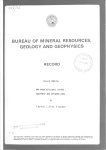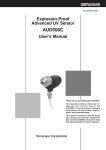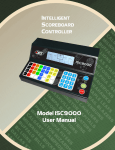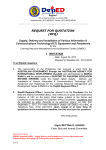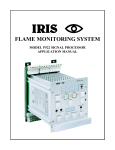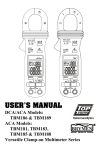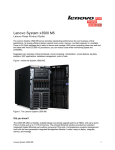Download FRS110 Multiburner Control FSG Relay User`s Manual
Transcript
No. CP-SP-1214E FRS110 Multiburner Control FSG Relay User's Manual Thank you for purchasing the FRS110 Multiburner Control FSG Relay. This manual contains information for ensuring the correct use of the FRS110. It also provides necessary information for installation, maintenance, and troubleshooting. This manual should be read by those who design and maintain equipment that uses the FRS110. Be sure to keep this manual nearby for handy reference. RESTRICTIONS ON USE This product has been designed, developed and manufactured for general-purpose application in machinery and equipment. Accordingly, when used in applications outlined below, special care should be taken to implement a fail-safe and/or redundant design concept as well as a periodic maintenance program. • Safety devices for plant worker protection • Start/stop control devices for transportation and material handling machines • Aeronautical/aerospace machines • Control devices for nuclear reactors Never use this product in applications where human safety may be put at risk. NOTICE Be sure that the user receives this manual before the product is used. Copying or duplicating this user’s manual in part or in whole is forbidden. The information and specifications in this manual are subject to change without notice. Considerable effort has been made to ensure that this manual is free from inaccuracies and omissions. If you should find an error or omission, please contact Yamatake Corporation. In no event is Yamatake Corporation liable to anyone for any indirect, special or consequential damages as a result of using this product. ©2006 Yamatake Corporation ALL RIGHTS RESERVED SAFETY PRECAUTIONS ■ About Icons The safety precautions described in this manual are indicated by various icons. Please be sure you read and understand the icons and their meanings described below before reading the rest of the manual. Safety precautions are intended to ensure the safe and correct use of this product, to prevent injury to the operator and others, and to prevent damage to property. Be sure to observe these safety precautions. WARNING CAUTION Warnings are indicated when mishandling this product might result in death or serious injury. Cautions are indicated when mishandling this product might result in minor injury to the user, or only physical damage to the product. ■ Examples Triangles warn the user of a possible danger that may be caused by wrongful operation or misuse of this product. These icons graphically represent the actual danger. (The example on the left warns the user of the danger of electric shock.) White circles with a diagonal bar notify the user that specific actions are prohibited to prevent possible danger. These icons graphically represent the actual prohibited action. (The example on the left notifies the user that disassembly is prohibited.) Filled-in black circles instruct the user to carry out a specific obligatory action to prevent possible danger. These icons graphically represent the actual action to be carried out. (The example on the left instructs the user to remove the plug from the outlet.) i WARNING Before removing, mounting or wiring the FRS110, be sure to turn the power OFF. Failure to do so might cause electric shock. Do not touch the terminals on the FSG relay. Doing so might result in an electric shock. This FSG relay is for batch operation (at least one start and stop in 24 hours of operation) needing a safe start feature. When using this product for continuous operation (continuous combustion for 24 hours or longer), combine it with the R4332A or R4332B which have a self-checking function. This FSG relay does not have the prepurge timing functions necessary for burner ignition. Take timer functions into consideration when designing your control system. Do not connect the solenoid valve to the voltage side. If a ground fault occurs, ground current will flow to the solenoid valve and open it, causing fuel to flow regardless of the state of this relay. Make sure that the pilot and main burner ignition times do not exceed the burner ignition time which the equipment manufacturer specifies. Excessively long ignition time might cause fuel to accumulate in the combustion chamber and an explosive air-fuel mix to form, resulting in the risk of a serious explosion. Before carrying out the pilot turndown test or ignition spark response test, be sure that all manual fuel valves are closed. Do not operate the FSG relay without completing the tests described in Chapter 4 and the tests specified by the equipment manufacturer. If the flame detector is set so that it detects a pilot flame that is too small to ignite the main burner, flame failure in the main burner will not be detectable. In this case, fuel would continue to be supplied, causing a serious explosion hazard. Be sure to carry out the pilot turndown test carefully. If the pilot turndown test must be carried out repeatedly, completely shut down all equipment each time the test is finished, and completely discharge unburned gas or fuel that has accumulated in the smoke ducts and combustion chamber. Failure to discharge unburned gas or fuel may result in an explosion. After the pilot turndown test is completed, turn the power OFF. Be sure to restore all test jumper leads, limit switches and control settings used in the test to their original settings. ii WARNING Connect the power source last to prevent electric shock or damage. If the power line accidentally touches the wrong terminal, electric shock or damage might result. Connect the load (ignition transformer, solenoid valve, etc.) to the output terminals directly. If it is not directly connected, combustion safety cannot be ensured. Do not extend the lead wires of the reset input for more than the allowable wiring length of 10 meters. Never input a reset command from a remote location where burner status cannot be checked. If the FRS110 locks the burner out, be sure to remove the cause before resetting. Do not repeatedly enter the reset input. Doing so could cause an explosion. Make sure that the ultraviolet flame detector cannot detect UV rays emitted by sources other than the burner. If the ultraviolet flame detector responds to other UV sources, it will report that there is a flame even if the burner flame is out. As a result, fuel will continue to be supplied, causing a very serious explosion hazard. CAUTION The FRS110 has extremely important functions for safe operation of equipment. Follow the instructions in the user’s manual to ensure safe use. Do not transport the FSG relay while it is mounted on a DIN rail. Before transporting, remove it from the subbase and pack it in its original packing case. If it is transported on a DIN rail, it might fall off and be damaged. Mounting, wiring, maintenance, inspection and adjustment should be carried out by a specialist who has been trained in how to handle burners and combustion safeguard equipment. Do not mount the FSG relay in the following locations: • Near corrosive chemicals or gases (ammonia, sulfur, chlorine, ethylene compounds, acid, etc.) • Where subject to water spray or extreme humidity • Where subject to high temperatures • Where subject to continuous vibration for a long time After wiring, be sure to check the wiring connections. Operating this device with wires wrongly connected might cause damage or malfunction. iii CAUTION Make sure that the loads connected to the terminals do not exceed the specified ratings. Make sure that power of the same voltage and frequency as indicated on the model number label is supplied to the FSG relay. When configuring control circuits, select reliable timers and auxiliary relays as necessary for additional functions. Be sure to ground this device using a lead with a resistance of less than 100Ω, and be sure to ground the burner body. Keep power lines and ignition transformer high-voltage cables separate from the flame detector wires. Run the ignition transformer high-voltage cable separately and keep it at least 10cm away from the FSG relay. When equipment is restarted after a safety shutoff, check all items described in Chapter 4, TRIAL-RUN ADJUSTMENT. Before maintenance and inspection of the burner, be sure to do the pilot turndown test. Carry out this test at least once every year. When cleaning the burner, clean the flame detector also. When mounting or wiring, be sure to follow the instructions in this user’s manual and manuals provided by the equipment manufacturer or other device manufacturers. Follow all applicable regulations when wiring. Make sure that ignition transformer high-voltage cables are properly connected to prevent contact failure. Poor contact might generate high-frequency radio waves, resulting in noise in radios or other electrical appliances, or causing malfunction. Also, connect the ignition transformer ground lead directly to the burner body, or to a metal part that is electrically connected to the burner body. iv Conventions Used in This Manual The following conventions are used in this manual: Handling Precautions: Handling Precautions indicate items that the user should pay attention to when handling the FRS110. Note: (1), (2), (3): Notes indicate information that might benefit the user. Numbers within parentheses indicate steps in a sequence or parts of an explanation. v Contents SAFETY PRECAUTIONS Conventions Used in This Manual Chapter 1. OVERVIEW ■ ■ ■ ■ ■ Chapter 2. Overview.......................................................................................................1-1 Features........................................................................................................1-1 Names and functions ..................................................................................1-2 Recommended flame relays and flame sensors.......................................1-2 FSG system configuration ..........................................................................1-3 MOUNTING AND WIRING 2.1 Mounting and Wiring the Subbase...................................................................2-1 2.2 Wiring..................................................................................................................2-3 ■ Wiring diagrams (FSG relay and flame relay) ...........................................2-4 ■ Wiring the power supply and the solenoid valve .....................................2-4 ■ Wiring the surge absorber ..........................................................................2-7 Chapter 3. OPERATION ■ Sequence diagrams.....................................................................................3-1 ■ Operation details .........................................................................................3-3 Chapter 4. TRIAL-RUN ADJUSTMENT ■ ■ ■ ■ ■ Chapter 5. Overview.......................................................................................................4-1 How to measure the flame signal...............................................................4-2 Pilot turndown test ......................................................................................4-3 Ignition spark response test.......................................................................4-5 Safety shutoff test .......................................................................................4-6 MAINTENANCE AND INSPECTION ■ Inspection cycle...........................................................................................5-1 ■ Troubleshooting ..........................................................................................5-2 Chapter 6. SPECIFICATIONS ■ Specifications ..............................................................................................6-1 ■ External dimensions....................................................................................6-2 vi Chapter 1. OVERVIEW ■ Overview The FRS110 multiburner control FSG relay (hereafter referred to as the FSG relay or the FRS110) is equipped with a burner ignition control function. When used in combination with the FRS100 flame relay functioning as a flame detector, the FSG relay is suitable for use in batch-operation (intermittent) combustion equipment. At startup, if there is any problem with the FRS110 or with the flame relay, burner ignition is prevented.The FRS110 has both a safe start function and a combustion safety shutoff function that closes the gas shutoff valve if a flame failure signal is received from the FRS100 during operation. A multiburner combustion safety control can easily be made by combining one FRS110 with multiple flame relays. Note that the FRS110 does not provide a prepurge timer function. ■ Features • The FRS110 can control synchronous multiburner ignition and shutdown when combined with multiple flame relays. • Upon startup, the FRS110's start check function is activated. If anything is abnormal, the FRS110 ensures safety by stopping the ignition process. Also, if there is an ignition failure or flame failure, the FRS110 maintains safety by initiating burner lockout. The FRS110's safe design ensures that the burner cannot be started until an external reset signal is received. • When lockout occurs, an alarm output signal is sent via the alarm contacts. • Because of its compact design, the FRS110 can be plugged into a wiring subbase, which can be mounted by screws or on a DIN rail. • LED indicators allow an easy status check of power, start signal input, alarm situation, ignition transformer, pilot valve, and main valve. 1-1 Chapter 1. OVERVIEW ■ Names and functions ● FRS110 LED indicators POWER (green): Power ON/OFF START (green): Start contact ON/OFF ALARM (red): Alarm ON/OFF FRS50A100 subbase (sold separately) DIN rail IG (red): Ignition transformer ON/OFF PV (red): Intermittent pilot valve ON/OFF MV (red): Main valve ON/OFF Cover removed Body mounting screw Dedicated connector for optional flame voltage meter (sold separately) Cover DIN rail locking tab M3.5 terminal screws Terminals for reset switch Terminals for alarm output ● FRS50A100 subbase (sold separately) ■ Recommended flame relays and flame sensors ● Flame relay and flame detector Flame relay FRS100B FRS100C Flame detector Ultraviolet Flame Detector Flame Rod Minipeeper Ultraviolet Flame Detector ● Optional parts (sold separately) Name 1-2 Model No. Subbase FRS50A100 Lightning surge absorber 83968019-001 C7012A/C C7007A, C7008A C7027A, C7035A Chapter 1. OVERVIEW ■ FSG system configuration The FRS110 provides ignition control, while the FRS100 flame relay detects the flame. To construct a multiburner system, take the following items into consideration: • Burner ignition and shutdown sequences • Method of safety shutdown in the event of flame failure ● Synchronous ignition and shutdown (two-burner case) Only one main valve and one pilot valve are needed for two burners. (For extra safety, redundant valves may be used, as shown in the diagram,) FSG Flame Flame relay relay relay Flame detector Ignition transformer Gas Main valve Ignition process: •The FRS110 ignites all pilot burners simultaneously, and then detects the pilot flame. •After the pilot flame confirmation period, the FRS110 opens the main valve and ignites the main burner. Pilot valve ● Asynchronous ignition and shutdown (two-burner case) One main valve and one pilot valve are needed for each burner. (For extra safety, redundant valves may be used, as shown in the diagram,) FSG Flame relay relay Flame detector Gas Main valve Ignition transformer Pilot valve Pilot valve Ignition transformer Main valve Ignition process: The FRS110 ignites and shuts off each burner individually. Flame detector FSG relay Flame relay 1-3 Chapter 2. 2.1 MOUNTING AND WIRING Mounting and Wiring the Subbase CAUTION Do not mount this control in the following locations: • Where subject to corrosive chemicals or gases (such as ammonia, sulfur, chlorine, ethylene compounds, acid.) • Where subject to water spray or extreme humidity • Where subject to high temperatures • Where subject to continuous vibration Do not transport the FSG relay while it is mounted on a DIN rail. Before transporting, remove it from the subbase and pack it in its original packing case. If it is transported on a DIN rail, it might fall off and be damaged. When mounting or wiring, be sure to follow the instructions in this user’s manual and manuals provided by the equipment manufacturer or other device manufacturers. ● Mounting location As shown below, keep a enough space around the control for heat radiation, and to facilitate mounting, removal, wiring and maintenance. Above: 50mm min. PRS 100 FSG RELAY POWER IG START PV ALARM MV PRS 100 FSG RELAY POWER IG START PV ALARM MV 20mm min. PRS 100 FLAM E RELAY • • • POWER IG START PV ALARM MV 20mm min. Below: 20mm min. Handling Precautions • If there is room, leave as much space as possible between the FRS and other FRS units to allow for heat radiation. • If ambient temperature is close to the allowable upper limit, reduce the internal temperature of the control panel by mounting a panel cooler or a cooling fan. Allowable ambient temperature upper limits: • Gang-mounting: 45°C • Stand-alone mounting: 60°C 2-1 Chapter 2. MOUNTING AND WIRING ● Mounting direction • Mount so that the arrow on the subbase is facing upwards. • Mount so that the display panel is in front. PRS 100 POWER FSG RELAY IG START PV ALARM MV ● Mounting on a DIN rail (1) Slide the DIN rail locking tab downwards. (2) Place the subbase on the DIN rail, with the arrow on the subbase facing upwards. (3) Slide the DIN rail locking tab to secure the subbase to the DIN rail. (4) Wire the subbase terminals as instructed in section 2.2, Wiring. (5) Pull the bottom of the cover forward to remove. (6) Insert the FRS110 into the subbase with the display panel in front. (7) Tighten the mounting screw in the center of the FRS110 attach it to the subbase, using a maximum torque of 0.3N•m. (8) Wire the alarm output signal and reset signal. (9) Reattach the cover. 32 UP M4 (2 locations) ● Mounting on panel directly (1) Drill two M4 mounting holes in the panel so that the arrow on the subbase will be facing upward. (2) Attach the subbase to the panel using two M4 screws at a maximum torque of 0.7N•m. Handling Precaution • Do not tighten the subbase mounting screws with a torque exceeding the maximum. (3) Wire the subbase terminals as instructed in section 2.2, Wiring. (4) Pull the bottom of the cover forward to remove. (5) Insert the FRS110 into the subbase with the display part upwards. (6) Tighten the mounting screw in the center of the FRS110 to attach it to the subbase, using with a maximum torque of 0.3N•m. (7) Wire the alarm output signal and reset signal. (8) Reattach the cover. 2-2 Chapter 2. MOUNTING AND WIRING 2.2 Wiring WARNING Connect the power source last to prevent electric shock or damage. If the power line accidentally touches the wrong terminal, electric shock or damage might result. Connect the load (ignition transformer, solenoid valve, etc.) to the output terminals directly. If it is not directly connected, combustion safety cannot be ensured. CAUTION When mounting or wiring, be sure to follow the instructions in this user’s manual and manuals provided by the equipment manufacturer or other device manufacturers. Follow all applicable regulations when wiring. Make sure that the loads connected to the terminals do not exceed the ratings indicated in the specifications. Make sure that power of the same voltage and frequency as indicated on the Model No. label is supplied to the FSG relay. When configuring control circuits, select reliable timers and auxiliary relays as necessary for additional functions. Be sure to ground this control using a lead with a resistance of less than 100Ω, and be sure to ground the burner body. Keep power lines and ignition transformer high-voltage cables separate from the flame detector wires. Run the ignition transformer high-voltage cable separately and keep it at least 10cm away from the FSG relay. Make sure that ignition transformer high-voltage cables are properly connected to prevent contact failure. Poor contact might generate highfrequency radio waves, resulting in noise in radios or other electrical appliances, or causing malfunction. Also, connect the ignition transformer ground lead directly to the burner body, or to a metal part that is electrically connected to the burner body. After wiring, be sure to check the wiring connections. Operating this device with wires wrongly connected might cause damage or malfunction. In setting the timer, follow the Japan Gas Association's Safety Engineering Directives for Industrial Gas Combustion Equipment or similar guidelines. Do not extend the lead wires of the reset input for more than the allowable wiring length of 10 meters. Never input a reset command from a remote location where burner status cannot be checked. 2-3 Chapter 2. MOUNTING AND WIRING ■ Wiring diagrams ● FRS110 with one flame relay (FRS100) Power supply (H) Power supply (G) Start switch Limit FRS110 1 5 2 Power circuit K1 8 K2 Input circuit 3 Pilot valve 6 Ignition transformer 1 4 Ignition circuit K1 K2 K2 K3 Alarm circuit K3 Reset input B A C 7 Main valve Reset switch 1 D Alarm 1 FRS100 1 7 Input circuit Start check circuit 2K 8 3 2 Power circuit 2K 4 Combustion lamp 1 1K Flame amplifying circuit 2K 5 6 Flame detector Handling Precautions • The power supply is marked H and G for the voltage and ground sides, respectively. Connect the voltage side (H) to terminal 1 and the ground side (G) to terminal 2. • Install the ignition transformer directly on the burner itself or on a metallic part electrically connected to the burner. • Use 2mm2 wire with indoor PVC insulation at each terminal. • Use indoor PVC-insulated wire at least 0.75mm2 (30 strands 0.18mm in dia.) for power connections. 2-4 Chapter 2. MOUNTING AND WIRING ● FRS110 with two flame relays (FRS100) Power supply (H) Start switch Power supply (G) CR2 CR3 CR4 CR8 Stop switch CR5 CR1 Start CR1 Reset switch 1 TM2 C D CR1 Limit CR6 1 5 CR7 CR2 FRS110 2 K1 CR3 3 8 K2 6 4 K2 7 A B CR4 CR5 Pilot confirmation timer TM1 TM1 Main valve TM2 Main Ignition timer CR8 Alarm 1 1 FRS100 7 2 1K 2K 8 3 4 Combustion lamp 1 5 6 CR6 Flame detector 1 1 FRS100 7 2 1K 2K 8 3 4 Combustion lamp 2 5 6 CR7 Flame detector 2 CR2 Pilot valve 1 CR3 Pilot valve 2 CR2 CR3 CR4 Ignition transformer 1 CR4 CR5 Ignition transformer 2 CR5 Handling Precautions • The power supply is marked H and G for the voltage and ground sides, respectively. Connect the voltage side (H) to terminal 1 and the ground side (G) to terminal 2. • Install the ignition transformer directly on the burner itself or on a metallic part electrically connected to the burner. • Use 2mm2 wire with indoor PVC insulation at each terminal. • Use indoor PVC-insulated wire at least 0.75mm2 (30 strands 0.18mm in dia.) for power connections. 2-5 Chapter 2. MOUNTING AND WIRING ■ Wiring of power supply and solenoid valve CAUTION Do not connect the solenoid valve to the voltage side. If a ground fault occurs, ground current will flow to the solenoid valve and open it, causing fuel to flow regardless of the state of this relay. FRS110 FSG relay Burner Power supply Ground side (G) N (Ground fault) L Combustion unit Voltage side (H) Valve (closed) Fuel ● Correct wiring When wiring is done correctly as shown in the above figure, ground fault current cannot flow to the solenoid valve, even if the fault was caused by an insulation failure on the voltage side (H). Therefore the valve does not open and there is no danger of fuel discharge. (Ground fault) FRS110 FSG relay Burner Power supply Ground side (G) N L Combustion unit Voltage side (H) Valve (open) Fuel ● Incorrect wiring If the valve is connected to the voltage side as illustrated above, ground fault current will flow to the solenoid valve and open it, discharging fuel. 2-6 Chapter 2. MOUNTING AND WIRING ■ Wiring the surge absorber Wire as shown below when using a surge absorber (model No. 83968019-001, ordered separately) for protection from lightning surge. Handling Precautions • Use at least JIS C 3306, 0.75mm2 power leads (30 strands 0.18mm in dia.) for wiring to the power supply. • Attach a Faston receptacle (AMP #187) to one end of the power leads, and make the wires as short as possible. • Ground the surge absorber mounting bracket by attaching to a grounded metal part such as the burner body. 2-7 Chapter 3. OPERATION ■ Sequence diagrams Power supply (H) Power supply (G) Start switch Limit FRS110 1 5 2 Power circuit K1 8 K2 Input circuit 3 Pilot valve 6 Ignition transformer 1 4 Ignition circuit K1 K2 K2 K3 Alarm circuit K3 Reset input B A C 7 Main valve Reset switch 1 D Alarm 1 FRS100 1 7 Input circuit Start check circuit 2K 8 3 2 Power circuit 2K 4 Combustion lamp 1 1K Flame amplifying circuit 2K 5 6 Flame detector • Normal operation [Input] Start input Flame signal input Term. 8 Term. 4 [Output] Ignition transformer Intermittent pilot valve Main valve Alarm output Term. 6 Term. 3 Term. 7 Term. A-B [Indicators] POWER START IG PV MV AL Safety Time Standby RUN Standby Start Check Time 3-1 Chapter 3. OPERATION • Ignition failure [Input] Start input Flame signal input Term. 8 Term. 4 [Output] Ignition transformer Intermittent pilot valve Main valve Alarm output Term. 6 Term. 3 Term. 7 Term. A-B [Indicators] POWER START IG PV MV AL Safety Time Standby Alarm Start Check Time • Flame failure [Input] Start input Flame signal input Term. 8 Term. 4 [Output] Ignition transformer Intermittent pilot valve Main valve Alarm output Term. 6 Term. 3 Term. 7 Term. A-B [Indicators] POWER START IG PV MV AL RUN Note: Alarm . The Flame Failure Response Time, the time from flame failure to flame signal shutoff, is dependent upon the FRS100 flame relay specifications. . Safety Time means pilot flame-establishing period. 3-2 Chapter 3. OPERATION ■ Operation details • Normal operation Input conditions FRS110 operation System status Start contact (terminal 8): ON •Ignition transformer starts operating. •Intermittent pilot valve Relay K1 remains ON during the Safety Time (ignition opens. trial time). Flame signal input (terminal 4): ON If terminal 4 receives flame signal input by the end of •Intermittent pilot valve the Safety Time (ignition trial time), relay K1 remains opens. ON, relay K2 is energized, and the regular combustion •Main valve opens. run begins. •Ignition transformer stops. Start contact (terminal 8): OFF If the power to terminal 8 is turned OFF, relays K1 and K2 are turned OFF. After power reaches terminal 8, and after the start check time has elapsed, relay K1 is turned ON. •Ignition transformer stops. •Main valve closes. • Ignition failure operation Input conditions FRS110 operation System status Start contact (terminal 8): ON After power reaches terminal 8, and after the start check time has elapsed, relay K1 is turned ON. •Ignition transformer starts operating. •Intermittent pilot valve Relay K1 remains ON during the Safety Time (ignition opens. trial time). Flame signal input (terminal 4): OFF If there is no flame signal input to terminal 4 by the •Ignition transformer end of the Safety Time (ignition trial time), relay K1 stops. turns OFF and an alarm signal (terminals A-B) is output. •Intermittent pilot valve closes. •Alarm output. • Flame failure operation Input conditions FRS110 operation System status Flame signal input (terminal 4): OFF If flame failure occurs during the regular combustion run, the flame signal turns OFF, relays K1 and K2 turn OFF, and an alarm signal is output to terminals A and B. •Intermittent pilot valve closes. •Main valve closes. •Alarm output. • False flame operation Input conditions Flame signal input (terminal 4): ON Start contact (terminal 8): ON FRS110 operation System status If, when power is supplied to terminal 8, a flame signal has already been input to terminal 4, the FRS110 does not begin the ignition trial, but waits until the flame signal stops. 3-3 Chapter 4. TRIAL-RUN ADJUSTMENT WARNING Make sure that the pilot and main burner ignition times do not exceed the bur ner ignition time which the equipment manufacturer specifies. Excessively long ignition time might cause fuel to accumulate in the combustion chamber and an explosive air-fuel mix to form, resulting in the risk of a serious explosion. Do not touch the terminals during trial operation adjustments. Doing so might result in an electric shock. Before removing, mounting or wiring the FRS110, be sure to turn the power OFF. Failure to do so might cause electric shock. Before carrying out the pilot turndown test or ignition spark response test, be sure that all manual fuel valves are closed. Do not operate this control without completing the tests described in this chapter and the tests of specified by the equipment manufacturer. If the FRS110 locks the burner out, be sure to remove the cause before resetting. Do not repeatedly enter the reset input. Doing so could cause an explosion. ■ Overview of adjustments The following table shows the items described in this chapter. Item Applicable FSG systems Flame signal measurement All Pilot turndown test Systems using a pilot burner Ignition spark response test Systems using an ultraviolet flame detector Safety shutdown test All Handling Precautions • After completing the above, make sure that all of the adjustment requirements are satisfied. All of the adjustment requirements must be satisfied by the final mounting position of the flame detector. ● Required items • Tester (input impedance of 100kΩ or more) Range: 0 to 300Vac, 0 to 5Vdc • Two jumper leads with crocodile clips, AWG14 (2mm2) or more, approximately 30cm long. • Insulation tester: 500Vdc megger ● Preliminary inspection • Check all wiring. • Make sure that the controller is mounted at a location within the permissible ambient temperature. • Make sure that the flame detector is properly mounted. (For details, see the flame detector user’s manual.) 4-1 Chapter 4. TRIAL-RUN ADJUSTMENT • Disconnect the loads and flame detector wiring. Measure the insulation resistance between the terminals and panel ground, and make sure that the resistance is 50MΩ or more using an insulation tester or megger of 500Vdc or more. • Valves and cocks on each of the fuel lines must be closed, and the fuel chamber must be thoroughly purged. ■ How to measure the flame signal (1) Start the equipment and measure the flame voltage for each burner under various conditions (at startup, normal operation, etc.). (2) When measuring the flame voltage, insert the tester probes into the holes for terminals A and B at the bottom front of the flame relay as shown below. FRS100 FLAME RELAY POWER FLAME Terminal A Terminal B Tester Input impedance of 100kΩ or more Black Red + – 0 to 5Vdc range (3) Refer to the following table for voltage: Flame detector Recommended Checklist flame voltage Minipeeper Ultraviolet 2Vdc min. • Make sure that the flame is correctly Flame Detector monitored. (C7027A or C7035A) • The front of the flame detector must be free of dirt. • The monitoring tube must not be blocked with soot. (4) If the flame signal fluctuates, check the flame detector mounting position and wiring again. 4-2 Chapter 4. TRIAL-RUN ADJUSTMENT ■ Pilot turndown test This test is for checking that even if gas pressure and air pressure are at their worst, any pilot flame that can be detected by the flame detector will reliably ignite the main burner. WARNING If the flame detector is set so that it detects a pilot flame that is too small to ignite the main burner, flame failure in the main burner will not be detectable. In this case, fuel would continue to be supplied, causing a serious explosion hazard. Be sure to carry out the pilot turndown test carefully. If the pilot turndown test must be carried out repeatedly, completely shut down all equipment each time the test is finished, and completely discharge unburned gas or fuel that has accumulated in the smoke ducts and combustion chamber. Failure to discharge unburned gas or fuel may result in an explosion. After the pilot turndown test is completed, turn the power OFF. Be sure to restore all test jumper leads, limit switches and control settings used in the test to their original settings. If this control is operated without restoring the original settings, equipment damage, gas leak, or explosion might result. CAUTION Only an experienced specialist who has knowledge and technical skills related to combustion equipment and combustion safety shoud carry out the pilot turndown test. Handling Precautions • If fuel pressure limit switches are open (in use) during this test, connect jumpers to set the limit switches ON. ● Procedure (1) Turn the power switch OFF. (2) Close the manual valve for the pilot and for the main burner to stop the gas flow. (3) Open the pilot manual valve. (4) Turn the power switch ON, and then turn the start switch on. The pilot will ignite. (5) Close the pilot manual valve slowly. The pilot flame will gradually grow smaller. Continue to close the manual valve until the flame detector can no longer detect the flame. At this point flame relays 1K and 2K turn OFF and lock out. Record the pressure just before the 2K flame relay turns off. 4-3 Chapter 4. TRIAL-RUN ADJUSTMENT (6) Then open the pilot manual valve slowly until the pressure matches the pressure just before the 2K flame relay turned off. (7) Reset the FSG relay, and restart the equipment, and then press the ignition switch again to ignite the pilot. (8) Make sure that the main burner ignites smoothly in one second or less when the main manual valve is opened. (9) Change the gas pressure from minimum to maximum, and ignite the main burner 5-6 times. Make sure that the main burner ignites smoothly every time. (10) If the main burner does not ignite, the reason is probably that the pilot flame is too small. Make the pilot flame larger and carry out the following adjustment: • Either move the flame detector's line of sight slightly away from the axis of the pilot flame, or put in a diaphragm to correct the flame size. (Set the flame size so that the main burnert ignites without fail at the minimum flame voltage.) (11) After adjusting, repeat steps (5) to (8), and make sure that main burner ignites without fail. (12) After this test is completed, return the main manual valve to its fully open position. Then, make sure that the flame signal is appropriate. (13) Take off any jumper leads connected to limit switches during this test to restore them to their original condition. 4-4 Chapter 4. TRIAL-RUN ADJUSTMENT ■ Ignition spark response test This test should be carried out on any equipment that uses an ultraviolet flame detector. The test is to check that the ultraviolet flame detector does not respond to UV rays emitted from the ignition spark. ● Ultraviolet Flame Detector CAUTION Make sure that the ultraviolet flame detector cannot detect UV rays emitted by sources other than the burner. If the ultraviolet flame detector responds to other UV sources, it will report that there is a flame even if the burner flame is out. As a result, fuel will continue to be supplied, causing a very serious explosion hazard. Carry out the following test to check that the ultraviolet flame detector does not respond to the UV rays emitted from the ignition spark. (1) Close the pilot manual valve and the main burner manual valve. (2) Begin operation and measure the flame voltage during the pilot ignition sequence to check for any influence from UV rays. (3) If the FLAME LED of the flame relay lights up, make one of the following adjustments, referring also to the equipment user’s manual. • Move the ultraviolet flame detector or ignition spark rod so that it is not affected. • Install a shield, for example, to prevent UV rays from the spark from entering the optical path of the ultraviolet flame detector, and adjust so that the influence of the spark on the flame voltage is 0.4Vdc or less. 4-5 Chapter 4. TRIAL-RUN ADJUSTMENT ● Cautions regarding UV sources other than flames The table below shows sources other than flames that emit UV rays that can be detected by the flame detector. Make sure that these UV sources do not influence operation of the ultraviolet flame detector under any operating conditions. UV relay sources 1260°C or higher red-hot chamber wall Sparks (ignition transformer, welding arc, lightning) Gas laser Sunlamp Sterilizing lamp Strong flashlight (in direction of UV photoelectric tube) All other UV sources Gamma ray and X-ray sources Diffraction analyzer Electron microscope X-ray machine High-voltage vacuum switch High-voltage capacitor Radioactive isotope All other gamma ray and X-ray sources ■ Safety shutoff test Carry out the safety shutoff test when all operating adjustments have been completed. • Pilot ignition failure (non-ignition) (1) Close the pilot manual valve and the main manual valve. (2) Press the start switch to start operation. (3) The pilot valve opens upon pilot ignition. However, since the pilot cannot light, the flame relay FLAME LED should not light up. Make sure that the main valve (controlled by the FSG relay) does not open. • Flame failure during normal combustion (1) Open the pilot manual valve and the main manual valve. (2) Press the start switch to start operation. (3) After the ignition sequence has proceeded normally, and normal combustion (main valve open) has begun, close the pilot manual valve and the main manual valve to turn the burner flame off. At this time, make sure that the flame failure is detected, and that the safety shutoff occurs. 4-6 Chapter 5. MAINTENANCE AND INSPECTION WARNING Before removing or mounting the FRS110, be sure to turn the power OFF. Failure to do so might cause electric shock. CAUTION Mounting, wiring, maintenance, inspection and adjustment should be carried out by a specialist who has been trained in how to handle burners and combustion safeguard iquipment. If this control is replaced, check all items described in Chapter 4, TRIAL-RUN ADJUSTMENT. Before maintenance and inspection of the burner, be sure to do the pilot turndown test. Carry out this test at least once every year. Periodically maintain and inspect the equipment as instructed in the equipment manufacturer’s user’s manuals. ■ Inspection cycle Determine an inspection cycle taking into consideration the following factors: • Type of equipment • Ambient conditions at the installation site (such as dust and temperature) • The effects of burner failure on equipment operation. 1. Carry out the safety shutoff test described in Chapter 4, TRIAL-RUN ADJUSTMENT, once per month. 2. Inspect the monitoring window on the flame detector, the flame rod, etc. for dirt, and clean as necessary. 3. Measure the flame voltage at least once per month to check its status. If burner shutdown will result in significant loss, carry out this inspection more frequently. 5-1 Chapter 5. MAINTENANCE & INSPECTION ■ Troubleshooting If there is some problem with the equipment, use the following check procedure: Turn off the start switch, and then push the reset switch. Does the POWER LED light up? Y Is the power within the allowable voltage range? N Does the pilot burner light up? N Is there voltage between terminals 5, 3, 6 and 2? Y Check the switches and fuses for the power. Check the wiring. Y N N Check wiring between FRS100 and FRS110 Replace the FRS110 Adjust the voltage. Y Is the FRS100 FLAME LED off? Y Check pilot burner and ignition transformer, and wiring Ignition spark response test Check burner N Disconnect the flame detector Does the FLAME LED (FRS100) turn on? Turn the start switch on. N Did the FLAME LED (FRS100) turn off? Y Replace the FRS100 Y Y Does the main burner ignite? Y N Check voltage and wiring of terminal 8 (FRS110) N N Check burner Check the flame detector Is there voltage between terminals 7 and 2? Y Did the start check LED (FRS100) light up? Close the main manual valve Y Is the flame extinguished ? Y N Check for main valve leakage Check burner Was an alarm signal output? Y Normal state N Replace the FRS110 Check the main burner Check the burner and wiring 5-2 N Does the flame simulator make the FLAME LED light up? Replace the FRS100 Y N Check voltage and wiring of terminal 7 (FRS100) Check the start switch Does the flame voltage exceed 1.0V? Y Check the burner Check the flame detector Did the start check LED (FRS100) light up? N N Check alarm operation Replace the FRS110 Chapter 6. SPECIFICATIONS ■ Specifications Model No. FRS110A100 Rated voltage FRS110A104 FRS110A200 100Vac (50/60 Hz) FRS110A204 200Vac (50/60 Hz) Allowable voltage -15 to +10% of rated voltage Power consumption 5.5W or less Start Check Time 2s max. Application Batch operation of oil, gas and oil-gas mixed combustion equipment Safety Time (ignition trial time) 8±2s 4±1s 8±2s 4±1s Reset response time 2s max. Behavior at flame failure Lockout Allowable ambient temperature Stand-alone mounting: Gang mounting (2 units or more): Allowable storage temperature -20 to +70°C Ambient humidity 90% RH or less at 40°C (without condensation) Vibration resistance 5m/s2 max., 10 to 55Hz or less for 2h each in X, Y and Z directions (when mounted on panel directly) Insulation resistance 50MΩ min. between terminals and ground terminal by 500Vdc megger (except reset input, terminals C and D) Dielectric strength No failure after apply ing 1500Vac for 1min or 1800Vac for 1s between terminals and ground terminal (except reset input, terminals C and D) Product life 100,000 operations (at room temperature and humidity, and rated voltage) Body color Gray -20 to +60°C -20 to +45°C Mounting method DIN rail mounting or wall mounting (using the FRS50A100 subbase) Mass FRS110B: Approx. 270g FRS50A100 subbase : Approx. 70g Optional parts (sold separately) Mounting subbase Lightning surge absorber Model No.: FRS50A100 Model No.: 83968019-001 ● Contact rating Terminal Load Contact rating 7 Ignition transformer 300VA 3 Intermittent pilot valve 200VA 6 Main valve 200VA 6-1 Chapter 6. SPECIFICATIONS ■ External dimensions ● FRS110 plugged into FRS50A100 subbase (Unit: mm) DIN rail FRS50A100 subbase (sold separately) FRS110 FRS110 FSG RELAY POWER START ALARM Cover *1. Space required for mounting and removing body *2. Space required for mounting and removing from DIN rail 6-2 IG PV MV Chapter 6. SPECIFICATIONS ● FRS50A100 subbase (sold separately) (Unit: mm) M3.5 terminal screw (8) DIN rail Subbase mounting holes (2) DIN rail locking tab 6-3 Revision History Printed date Manual Number Edition Nov. 2006 CP-SP-1214E 1st Edition Revised pages Description Specifications are subject to change without notice. Advanced Automation Company 1-12-2 Kawana, Fujisawa Kanagawa 251-8522 Japan URL: http://www.azbil.com Printed on recycled paper. (07) Printed in Japan. 1st Edition: Issued in Nov. 2006 (U)








































